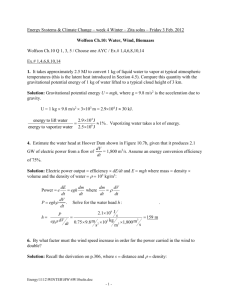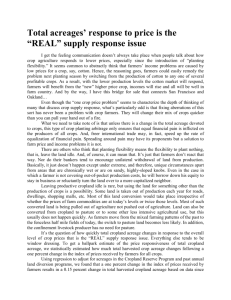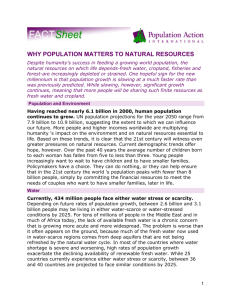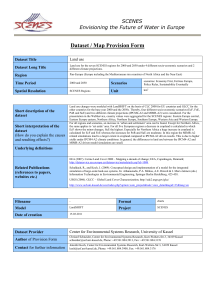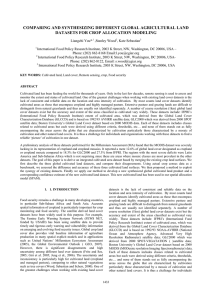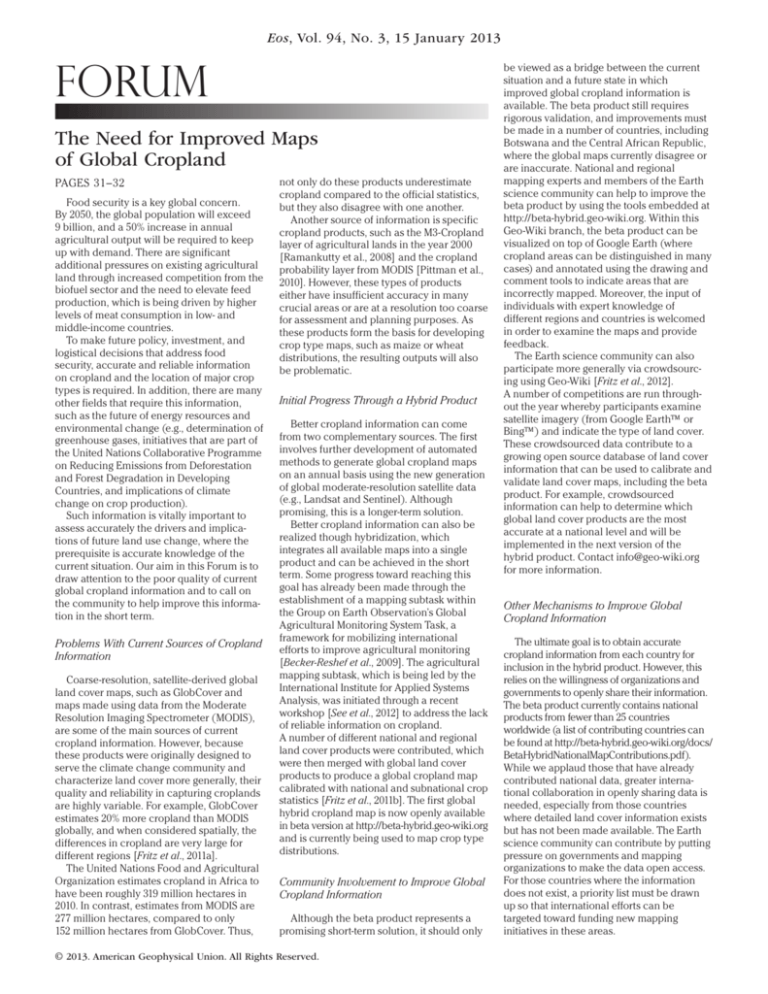
Eos, Vol. 94, No. 3, 15 January 2013
FORUM
The Need for Improved Maps
of Global Cropland
PAGES 31–32
Food security is a key global concern.
By 2050, the global population will exceed
9 billion, and a 50% increase in annual
agricultural output will be required to keep
up with demand. There are significant
additional pressures on existing agricultural
land through increased competition from the
biofuel sector and the need to elevate feed
production, which is being driven by higher
levels of meat consumption in low- and
middle-income countries.
To make future policy, investment, and
logistical decisions that address food
security, accurate and reliable information
on cropland and the location of major crop
types is required. In addition, there are many
other fields that require this information,
such as the future of energy resources and
environmental change (e.g., determination of
greenhouse gases, initiatives that are part of
the United Nations Collaborative Programme
on Reducing Emissions from Deforestation
and Forest Degradation in Developing
Countries, and implications of climate
change on crop production).
Such information is vitally important to
assess accurately the drivers and implications of future land use change, where the
prerequisite is accurate knowledge of the
current situation. Our aim in this Forum is to
draw attention to the poor quality of current
global cropland information and to call on
the community to help improve this information in the short term.
Problems With Current Sources of Cropland
Information
Coarse-resolution, satellite-derived global
land cover maps, such as GlobCover and
maps made using data from the Moderate
Resolution Imaging Spectrometer (MODIS),
are some of the main sources of current
cropland information. However, because
these products were originally designed to
serve the climate change community and
characterize land cover more generally, their
quality and reliability in capturing croplands
are highly variable. For example, GlobCover
estimates 20% more cropland than MODIS
globally, and when considered spatially, the
differences in cropland are very large for
different regions [Fritz et al., 2011a].
The United Nations Food and Agricultural
Organization estimates cropland in Africa to
have been roughly 319 million hectares in
2010. In contrast, estimates from MODIS are
277 million hectares, compared to only
152 million hectares from GlobCover. Thus,
not only do these products underestimate
cropland compared to the official statistics,
but they also disagree with one another.
Another source of information is specific
cropland products, such as the M3-Cropland
layer of agricultural lands in the year 2000
[Ramankutty et al., 2008] and the cropland
probability layer from MODIS [Pittman et al.,
2010]. However, these types of products
either have insufficient accuracy in many
crucial areas or are at a resolution too coarse
for assessment and planning purposes. As
these products form the basis for developing
crop type maps, such as maize or wheat
distributions, the resulting outputs will also
be problematic.
Initial Progress Through a Hybrid Product
Better cropland information can come
from two complementary sources. The first
involves further development of automated
methods to generate global cropland maps
on an annual basis using the new generation
of global moderate-resolution satellite data
(e.g., Landsat and Sentinel). Although
promising, this is a longer-term solution.
Better cropland information can also be
realized though hybridization, which
integrates all available maps into a single
product and can be achieved in the short
term. Some progress toward reaching this
goal has already been made through the
establishment of a mapping subtask within
the Group on Earth Observation’s Global
Agricultural Monitoring System Task, a
framework for mobilizing international
efforts to improve agricultural monitoring
[Becker-Reshef et al., 2009]. The agricultural
mapping subtask, which is being led by the
International Institute for Applied Systems
Analysis, was initiated through a recent
workshop [See et al., 2012] to address the lack
of reliable information on cropland.
A number of different national and regional
land cover products were contributed, which
were then merged with global land cover
products to produce a global cropland map
calibrated with national and subnational crop
statistics [Fritz et al., 2011b]. The first global
hybrid cropland map is now openly available
in beta version at http://beta-hybrid.geo-wiki.org
and is currently being used to map crop type
distributions.
Community Involvement to Improve Global
Cropland Information
Although the beta product represents a
promising short-term solution, it should only
© 2013. American Geophysical Union. All Rights Reserved.
be viewed as a bridge between the current
situation and a future state in which
improved global cropland information is
available. The beta product still requires
rigorous validation, and improvements must
be made in a number of countries, including
Botswana and the Central African Republic,
where the global maps currently disagree or
are inaccurate. National and regional
mapping experts and members of the Earth
science community can help to improve the
beta product by using the tools embedded at
http://beta-hybrid.geo-wiki.org. Within this
Geo-Wiki branch, the beta product can be
visualized on top of Google Earth (where
cropland areas can be distinguished in many
cases) and annotated using the drawing and
comment tools to indicate areas that are
incorrectly mapped. Moreover, the input of
individuals with expert knowledge of
different regions and countries is welcomed
in order to examine the maps and provide
feedback.
The Earth science community can also
participate more generally via crowdsourcing using Geo-Wiki [Fritz et al., 2012].
A number of competitions are run throughout the year whereby participants examine
satellite imagery (from Google Earth™ or
Bing™) and indicate the type of land cover.
These crowdsourced data contribute to a
growing open source database of land cover
information that can be used to calibrate and
validate land cover maps, including the beta
product. For example, crowdsourced
information can help to determine which
global land cover products are the most
accurate at a national level and will be
implemented in the next version of the
hybrid product. Contact info@geo-wiki.org
for more information.
Other Mechanisms to Improve Global
Cropland Information
The ultimate goal is to obtain accurate
cropland information from each country for
inclusion in the hybrid product. However, this
relies on the willingness of organizations and
governments to openly share their information.
The beta product currently contains national
products from fewer than 25 countries
worldwide (a list of contributing countries can
be found at http://beta-hybrid.geo-wiki.org/docs/
BetaHybridNationalMapContributions.pdf).
While we applaud those that have already
contributed national data, greater international collaboration in openly sharing data is
needed, especially from those countries
where detailed land cover information exists
but has not been made available. The Earth
science community can contribute by putting
pressure on governments and mapping
organizations to make the data open access.
For those countries where the information
does not exist, a priority list must be drawn
up so that international efforts can be
targeted toward funding new mapping
initiatives in these areas.
Eos, Vol. 94, No. 3, 15 January 2013
If the global community is serious about
accurately determining land use change and
planning sustainably for a highly uncertain
future, it is fundamental that stakeholders
recognize the need for better cropland
information as a vital ingredient in this
process. With higher resolution and better
calibrated data on the spatial and temporal
patterns of agricultural land use, the
scientific and policy communities will be
much better placed to reliably evaluate land
use policies, explore long-term sustainability,
and better evaluate tradeoffs between, e.g.,
food and biofuel feedstock production or
between biofuel production and afforestation projects. The Earth science community
can help achieve this goal.
References
Becker-Reshef, I., C. Justice, O. Leo, W. Bingfang, and
J. S. Parihar (2009), Building a global agricultural
monitoring system of systems: An overview of the
GEO Agriculture Monitoring Task, Earthzine, 22 Dec.
Fritz, S., et al. (2011a), Highlighting continued
uncertainty in global land cover maps to the user
community, Environ. Res. Lett., 6(4 ), 044005.
Fritz, S., et al. (2011b), Cropland for sub-Saharan
Africa: A synergistic approach using five land
cover data sets, Geophys. Res. Lett., 38, L04404,
doi:10.1029/2010GL046213.
Fritz, S., et al. (2012), Geo-Wiki: An online platform
for improving global land cover, Environ. Modell.
Software, 31, 110 –123.
Pittman, K., et al. (2010), Estimating global
cropland extent with multi-year MODIS data,
Remote Sens., 2, 1844 –1863.
Ramankutty, N., A. T. Evan, C. Monfreda, and J. A.
Foley (2008), Farming the planet: 1. Geographic
distribution of global agricultural lands in the
year 2000, Global Biogeochem. Cycles, 22,
GB1003, doi:10.1029/2007GB002952.
See, L., et al. (2012), Building a consolidated
community global cropland map, Earthzine, 24 Jan.
—STEFFEN FRITZ AND LINDA SEE, Ecosystem
Services and Management Program, International
Institute of Applied Systems Analysis (IIASA),
Laxenburg, Austria; E-mail: fritz@iiasa.ac.at;
LIANGZHI YOU, International Food Policy Research
Institute (IFPRI), Washington, D. C. ; CHRIS JUSTICE
and INBAL BECKER-RESHEF, University of Maryland,
College Park; LIEVEN BYDEKERKE, Flemish
Institute for Technological research (VITO), Mol,
Belgium; RENATO CUMANI, Food and Agriculture
© 2013. American Geophysical Union. All Rights Reserved.
Organization of the United Nations (FAO), Rome,
Italy; PIERRE DEFOURNY, Catholic University of
Louvain, Louvain-la-Neuve, Belgium; K ARLHEINZ
ERB, Institute of Social Ecology, Vienna, and AlpenAdria-University Klagenfurt, Vienna, Graz, Austria;
JON FOLEY, University of Minnesota, Minneapolis;
SVEN GILLIAMS, VITO, Mol, Belgium; PENG GONG,
University of California, Berkeley and Tsinghua
University, Beijing, China; MATT HANSEN, University
of Maryland, College Park; THOMAS HERTEL,
Purdue University, West Lafayette, Ind.; MARTIN
HEROLD, Wageningen University, Wageningen,
The Netherlands; MARIO HERRERO, International
Livestock Research Institute (ILRI), Nairobi, Kenya;
FRANCOIS K AYITAKIRE, Joint Research Centre of
the European Commission (JRC), Ispra, Italy; JOHN
L ATHAM, FAO; OLIVIER LEO, JRC; IAN MCCALLUM
and MICHAEL OBERSTEINER, IIASA; NAVIN
R AMANKUTTY, McGill University, Montreal, Canada;
JANSLE ROCHA, State University of Campinas,
Campinas, Brazil; HUAJUN TANG, Chinese Academy
of Agricultural Sciences (CAAS), Beijing, China;
PHILIP THORNTON, CGIAR program on Climate
Change, Agriculture and Food Security (CCAFS),
ILRI; CHRISTELLE VANCUTSEM, JRC; MARIJN VAN
DER VELDE, IIASA; STAN WOOD, IFPRI; and CURTIS
WOODCOCK, Boston University, Boston, Mass.



